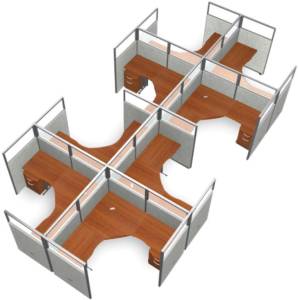Noise is not the only culprit of lessened productivity, according to Main Street’s Kerri Fivecoat-Campbell. In her article, “10 Ways to Trick Out Your Cubicle for Maximum Productivity,” she likened early cubicles to plain grey pods and insisted that early designs left little room for personality and personalization. Within the research conducted, she states that some of the key elements for employee happiness, and therefore productivity, included colors, photos, headphones. She states that colors have subconscious impact, photos can be used to transcend a frustrating conversation, and headphones can help to block noise and invite calming tones. She doesn’t, however, address how those who build and design cubicles could potentially impact productivity.
True, noise and lack of personalization are much of where dissatisfaction and employee unhappiness stem from (studies from UC Berkeley highlighting speech privacy as another). True, some companies are even investing time and budget percentages into pink-noise systems created to match the frequencies of human voices but to sound like ventilation, all for higher productivity (Tierney, 2012). But, cubicles in and of themselves are transforming into more welcoming work spaces with updated designs, colors and materials. These changes could result in significant changes to employee satisfaction.
At San Diego Office and Modular Design, we too have read the studies on employee satisfaction and have multiple designs to fit the needs of professional spaces. From the diversity of sizes, colors, desk shapes and materials, we support the modular employees and their need for individual characterization in conjunction with productivity. For the more open-concept workspaces that call for more interaction, there are options of Plexiglass between stations and less surrounding wall space. For those in need of wider desk areas for large projects, we provide desks of 48 inches up to 72 inches both for single and double workstations. In addition, there is always a choice of colors for both wall panels and desk surfaces. Cubicle counter-culture is developing to incorporate sound proofing and extensive personalization. Starting within the design of the cubicles is our first step.
If you're looking for office cubicles, feel free to call, email, chat, or shop online on our website at San Diego Office Furniture & Modular Design

Sources
Fivecoat-Campbell, K. (2011, Oct 05). 10 ways to trick out your cubicle for maximum productivity. Retrieved April 11, 2013, from http://www.mainstreet.com/slideshow/career/10-ways-trick-out-your-cubicle-maximum-productivity
Tierney, J. (2012, May 19). From cubicles, cry for quiet pierces office buzz. Retrieved April 11, 2013, from http://www.nytimes.com/2012/05/20/science/when-buzz-at-your-cubicle-is-too-loud-for-work.html?pagewanted=all
Ziegler Learning LLC. (2013). Cubicles may be disastrous for employee productivity. Retrieved April 11, 2013, from http://kztraining.com/wp-content/uploads/Cubicles-May-Be-Disastrous-to-Employee-Productivity.pdf